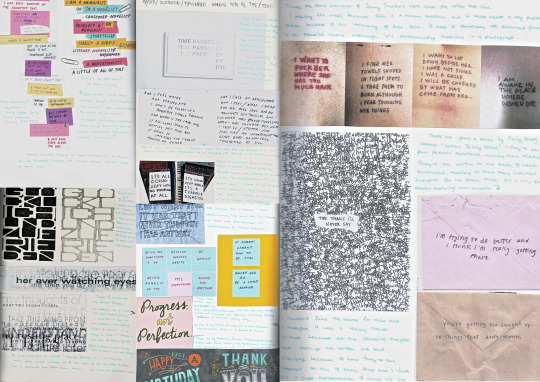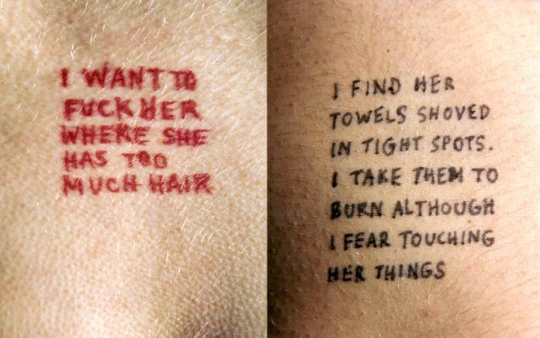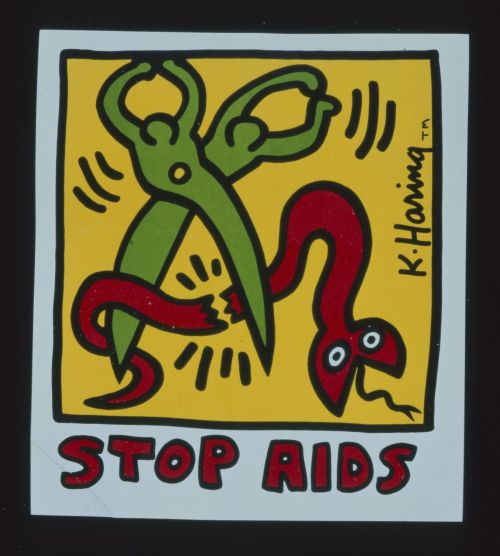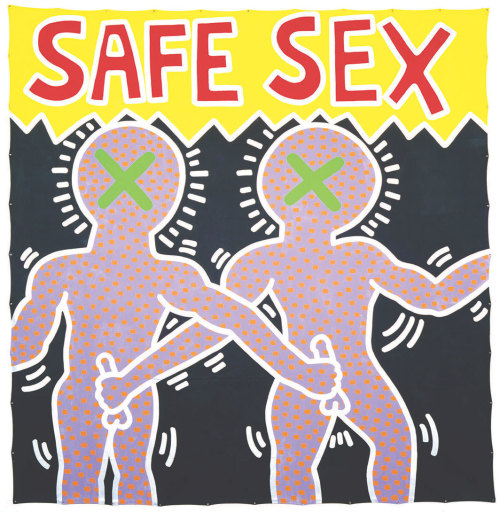#artist research

I looked at some different artists who just use typography and text to get some ideas and inspiration. The things I like most are very small, detailed and intimate because I think they portray a way of documenting thoughts and feelings, but because the brief is to make each page a3 size, this would not really be appropriate.
Within my research I found Jenny Holzer’s pieces, where she writes onto skin in ink, recounting sex crimes.


The creepy, honest, personal accounts work really effectively written onto the skin because it’s so intimate and delicate, and being that close up to skin creates the feeling of being very vulnerable. I then used this idea as using skin as a surface and wrote onto my skin.

Using skin as a surface was also really relevant for my quotes because I’m talking about society’s expectations of the way women ‘should’ look - as hairless, but my body hair goes against this and shows the reality of what women look like when they don’t follow these standards created by them for society.
I also looked at Tracy Emin’s textiles banner pieces.

These were really relevant to me, and she was playing with this same contradiction I had been experimenting with before, of using something traditionally feminine, but contrasting it with what the words were actually saying. The Tate’s summary of ‘hate and power can be a terrible thing’ says ‘They transform the concept of the traditionally nurturing, feminine craft of quilt-making into an arena for angry self-expression and revelation.’The words are very open and expressive, which is what I liked about the previous small, intimate works I looked at, but having these private thoughts displayed in a very large and accessible manner is very bold and interesting to see.
We also did a workshop where we were given a random article, and blank white booklet, and asked to make something in three colours, and all image or all text. My article was about rainfall causing toxic algae in a river that was polluting tap water. I chose to use all image because using all text was making me feel a bit stuck creatively. I used very abstract imagery, focusing mostly on colour and texture, and I found this exercise really helpful because it made me think about colour, techniques and use of space in a more creative way, so helped me feel more inspired about making my final book.

Photo Essay - Studio Orta (France) & Metal (Peterborough) Harvest Lab Residency (June 2015)
Further information here:
http://www.metalculture.com/projects/harvest-festival/
http://www.studio-orta.com/en/les-moulins
Post link
Another sketchbook page. Jenny Saville artist research. Let me know if you guys would like to see more sketchbook pages!!
Post link
ARTIST RESEARCH: KEITH HARRING
Keith Harring (May 4, 1958 – February 16, 1990) was an American artist who came to prominence out of the New York graffiti scene during the 1980′s. His early influences included the likes of Dr. Seuss and Walt Disney, as well as his father, who was an amateur cartoon artist.
Harring’s style became a familiar sight in the New York City subways, and as his popularity rose, he began producing much larger works, in a very stripped down yet highly energetic style.
Much of his work was embodied by social activism, namely AIDS awareness and the promotion of safe-sex ideals. A gay man himself, he was a victim of the AIDS crisis in the 80′s and the ignorance and stigma around it.
Speaking on the AIDS crisis and the influence it had on ‘The Downward Spiral’ track ‘Heresy”, Trent Reznor has said:
Harring spoke of and spread awareness of the AIDS epidemic at a time when the country and the politicians who ran it refused to acknowledge its existence. Despite the virus being identified in 1981, President Ronald Reagan himself did not even utter the word in public until the end of his two term presidency. This hesitancy to act would inevitably only worsen the situation. As the epidemic spread like wildfire, so too did the ignorance and ostracism directed towards the gay community.
Harring himself would eventually die from the disease in 1990, at the age of 31.
Post link













